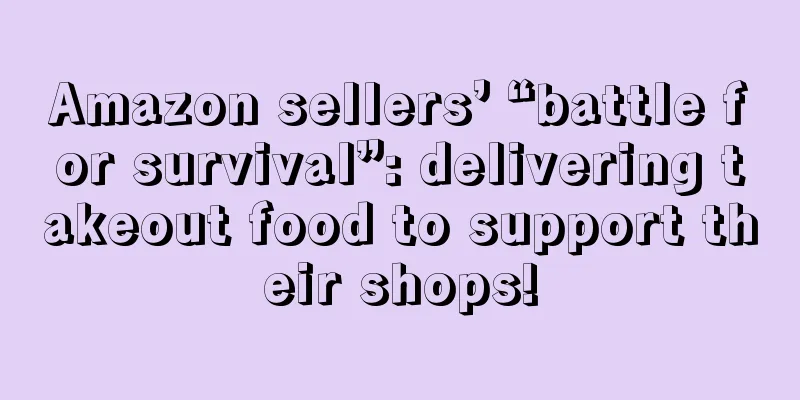Amazon sellers’ “battle for survival”: delivering takeout food to support their shops!

|
In the mainstream cross-border e-commerce market, no matter what the market environment is, competition has never eased, and small and medium-sized sellers used to be able to gain something. But times have changed, and today's "battle for survival" is becoming more and more difficult.
Monthly sales of $30,000 dropped to $2,000! Xiaomai: Old products are not selling well, and new products cannot be launched
Last May, Rory resigned from his job in Shenzhen and returned to his hometown to start a business, transforming himself from an Amazon operator to a seller.
“Maybe things were smooth in the beginning, but now I feel the difficulty of starting a business,” Rory told Ennet.
When in Shenzhen, the category Rory was in charge of had a maximum monthly sales of US$200,000, and a minimum of tens of thousands of dollars. At that time, he was ambitious and resigned from the company and decided to become his own boss.
“At the beginning, I sold products in categories that I had operated before because they were familiar and easier to get started with,” Rory said. He said that choosing familiar categories can basically ensure the profit and loss balance of the store in the early stage.
Later, the market trend of the product gradually declined, and Rory began his journey of product selection. "It took about two months, with constant trial and error. Two months later, I launched two products, which sold well. After that, I launched a few similar products, which caught up with the Black Friday and Cyber Monday at the end of last year. Although everyone cried and said that there were no orders, I thought that I just didn't make as much as before. After all, as a novice, I made more than 1,000 orders."
Like most small sellers on Amazon, Rory's products have a low average order value, which basically remains at around US$20. "In the early stage, it is easy to get orders with a low average order value, and the risk is also low. However, the cost of a high average order value is too high, so I dare not invest."
According to Rory, during the peak season at the end of last year, his store's monthly sales reached $30,000 . "Although the number is not large, for a newbie like me, it gives me hope."
But things are unpredictable. "After the Chinese New Year, it seemed like all the old products were cursed. All of a sudden, the order volume flattened out. For several months, the sales volume remained at a few thousand dollars."
At the end of April, Rory decided to launch a new product. However, "It seems that Amazon has no new product period now. After launching 3 products, the exposure and bidding are very confusing. In the past, the support period for new products was 1-3 months, but now it seems that there is no support period at all. Many keywords of the product are clearly at the top of the search keywords, but there is no exposure and clicks . "
There are many sellers who feel the same as Rory. On a forum, a seller said that he had put several derivatives of old products on the shelves, but the promotion period was very different from before:
" At the beginning of the year, I was full of confidence , thinking that I could continue the glory of last year's peak season and make thousands of dollars a day a normal thing . This idea was a bit naive. The number of orders started small during the peak season, and I thought it was the beginning of a surge in orders, but I never expected it to be the peak. After the New Year, the store's monthly sales were as low as 2,000 US dollars ," Rory said helplessly.
Rory said that his store's sales and volume have been declining, from January to March. In April, the GMV of new products still could not be increased . There were almost no orders for old products, and new products could not be promoted. " It's only been a year. Is the life cycle of Amazon products so short now ? "
In the current market downturn, some people think that small and medium-sized sellers are more popular, "small size, low risk"; others think that only big sellers can cope with the market freely. And data shows that on Amazon, top sellers account for 50% of GMV .
The top sellers account for 50% of GMV , while small sellers make money by delivering food to support their stores.
Marketplace Pulse data shows that in 2022, 15,000 sellers on Amazon's US site received more than 100,000 orders , and these sellers contributed nearly half of the third-party seller market sales (GMV) , a trend similar to previous years.
Additionally , there are 30,000 sellers with more than 50,000 orders in total (this includes sellers with more than 100,000 orders).
Marketplace Pulse classifies Amazon sellers with more than 100,000 orders as top sellers , and this group of sellers had a total order volume of more than 1 billion last year .
There are many people who are willing to join Amazon. Although there is no latest data, as of the first half of 2021, the total number of Amazon sellers worldwide has reached 6.3 million . As the most popular site, the number of sellers on the US site must account for a very high proportion. Against the backdrop of this huge group of sellers, only 30,000 sellers have more than 50,000 orders per year.
At the same time, earlier data from Marketplace Pulse showed that among the top 10,000 sellers on Amazon’s US site , 20% of the sellers have topped the Best Seller list in the corresponding category for seven consecutive years .
Obviously, it is becoming increasingly difficult for small and medium-sized sellers to survive on Amazon, which is "monopolized" by the top sellers .
In an interview with Ennet, a seller said, " Last year and this year were the most competitive years in my eight years of cross-border business . Not to mention new sellers, even old sellers find it difficult, with too many sellers and too little porridge . "
Many sellers also revealed the difficult situation of this "Amazon battle":
——I am totally spending more than I earn. I feel busy every day but have no results. I am so exhausted! ——I’ve been thinking about whether I should go to work for a while . ——The shops are basically left to their own devices. ——I have to start over as a worker. Because the store is self-delivering, I will purchase and ship goods when there is an order, and put them aside when there is no order. …
Some sellers even told Ennet that they are now delivering food to support their Amazon stores. " Now the delivery fee for delivering food is about 1 yuan per kilometer , and the advertising fee is more than 1,000 US dollars. It takes about 7,000 kilometers to subsidize the Amazon advertising fee. "
“ Now I just can’t get any orders , even if I launch FBA , even if I run paid ads, even if I optimize the description , keywords , title , brand story , etc. … still no orders! I can’t even pay for the ads, and now doing business on Amazon is just competing with myself . ”
Why are there no orders? In addition to economic factors, many sellers think it is related to Temu. " Whenever Temu holds an event, Amazon's sales are not good . "
It is difficult to define whether it is the influence of Temu, but since the beginning of this year, the natural search traffic on Amazon has indeed been declining.
It is difficult to place orders and traffic is low, so small and medium-sized sellers and new sellers have less and less room to survive on Amazon. Marketplace Pulse survey shows that most top sellers have been operating on Amazon for more than five years . According to the sales distribution pattern of all Amazon sites, a large part of the sales on the platform comes from top sellers .
With increasingly fierce competition and rising costs , there are still thousands of new sellers joining Amazon, but how long can they survive? Can small sellers afford to ignore profits and use low prices to grab market share in the long run? Amazon Seller |
<<: Tips for TikTok operation from foreign digital marketing experts
Recommend
Amazon is conducting another strict inspection and some sellers’ stores have been closed!
Recently, many sellers have received official ema...
The hot-selling product was accused of causing cancer, and the brand announced a global suspension of sales!
Recently, Johnson & Johnson announced that it...
What is Haiyan Cross-border Alliance? Haiyan Cross-border Alliance Review, Features
<span data-docs-delta="[[20,{"gallery"...
Russia's e-commerce retail share will double, and demand for these categories will rebound
Recently, Denis Manturov, Minister of Industry an...
Online shopping to account for 51% of global sales post-pandemic
Foreign media reported that after the pandemic, o...
Cross-border online shopping rate reaches 80%! Luxembourg market is worth paying attention to
Europe is another big piece of cake for cross-bor...
The number of independent sites increased by 116%, and Shopify now expands its TikTok channel to the UK
According to techdigest , TikTok and Shopify anno...
What is Marc Jacobs? Marc Jacobs Review, Features
Marc Jacobs is an American brand founded in 1986 b...
Amazon has a massive advertising system problem
There is a problem with Amazon's system again...
What is Senxun Overseas Consulting? Senxun Overseas Consulting Review, Features
Senxun Overseas Consulting is committed to provid...
Amazon US updates direct delivery policy, eBay will be able to cancel "timeout and unpaid" orders
Amazon US updates direct delivery policy Recently...
What is TOSAN ERP? TOSAN ERP Review, Features
TosanErp is a free e-commerce ERP that serves more...
Many countries are closely advancing the RCEP process, and Thailand becomes the first ASEAN member country to ratify the agreement
The center aims to better provide Thai people and...
What is XTransfer? XTransfer Review, Features
XTransfer is a financial technology company that f...
Australian Online Shopping Preference Study
Australian shoppers value timeliness of delivery ...









